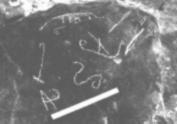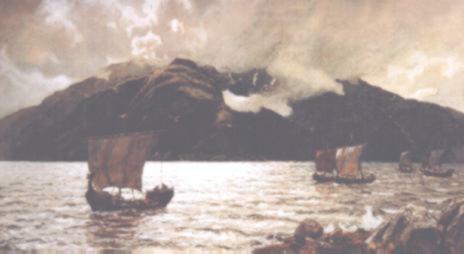
The Unwritten History Of Australia
Chapter 22
|
White Gods from the West Vikings explore the Pacific |
They fared like men far after gold,
and in the east gave the eagle food.
They died southward in Serkland."
Swedish inscription on
the Gripsholm stone,
Sodermanland.
11th century.
|
Pyramids
in the Pacific Ch 22
|

|
Viking Inscriptions
How well I recall, as a child, listening to my Scottish father's stories of Mediaeval Scotland, and of the Viking raiders who stormed its shores in search of booty and women...And at school I was taught that Viking warriors were axe-wielding, blood thirsty looters known to drink huge draughts of mead from the skulls of their enemies; that they confined themselves to the coast of northern Europe, hardly venturing beyond sight of the mainland, except to carry out raids on the British Isles.
After all, to sail out of sight of land was to risk falling off the edge of the world into limbo. Modern scholarship has drawn a completely new image of the Vikings; one that goes beyond the 'popular' coastal raider to show that, they were also a people possessing a unique, rich culture; that they produced great artisans, scholars, geographers and explorers, and they believed in a round earth!!!
Far from confining themselves to northern European seas, their explorers and traders penetrated the Mediterranean, sailed down the African coast, explored the rivers of eastern Europe, penetrated the near-east, discovered Iceland, Greenland and North America centuries before the time of Columbus. Indeed, it is my intention to present much generally unknown and startling evidence, to show that these bold adventurers penetrated to Australia, the Pacific Islands and Antarctica.
But who exactly were the Vikings?
Early commentators such as Pliny the Elder {22-79 AD}; Tacitus {55-120 AD} and Ptolemy {2nd century AD} wrote of several tribes of people inhabiting Scandinavia. Pytheas, about 300 BC described Norway and naming it Thule, wrote that:
"for lack of crops and cattle of more genial lands,
its inhabitants subsist on wild berries and 'millet',
which they thresh in covered barns because of
the continual rains.
From the plentiful honey of their bees
they prepare mead as a drink."
These commentators all describe a particular tribe called the Suiones, ie the Swedes {Sviar} of Uppland, who of all the Scandinavian tribes were to become the richest. The history of Scandinavia dates from Bronze Age times when the Tifinag alphabet was employed in rock inscriptions. Well known sites where this Norse script occurs are located in Bohuslan, Sweden. Here fleets of ancient vessels are depicted and accounts of trading voyages and raids given.
The pre-Viking Age adventurers may have been some of the raiders of the Egyptian coast included in the Phoenicians and Celts under the general term "Sea Peoples". Bronze Age Norse petroglyphs found in 1954 by Canadian field geologist near Peterborough, Ontario features vessels resembling the Bohuslan ship engravings. Translations made of these inscriptions speak of a religious centre established by Norse traders who were exchanging woven textiles for copper ingots produced by the local Algonquin Indians around 1700 BC...

|
Viking Long Ships